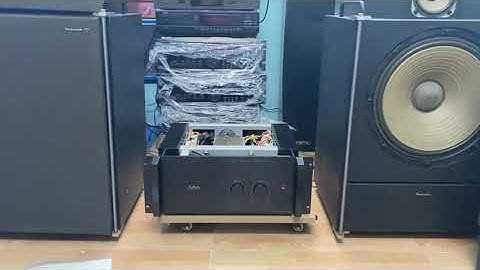Pro-Ject is otherwise perhaps best known for their turntables, and has managed to create models with good performance, and where some of the models have a very affordable price. But they also have a large selection of electronics in a compact package, with everything from RIAA-stages, amplifiers, CD players, DACs and streamers. Show This extensive experience with compact electronics design should of course given ample opportunity to drill in the recipe for how to make the ultimate compact integrated amplifier - one peels simply away as many functions as possible , and limits the number of inputs to a minimum. It is in itself a masterpiece to physically accommodate all these inputs on the amplifier's rear panel, a panel with dimensions less than 20x3cm. There are few places where they have had to make special efforts to make this happen. The otherwise attractive speaker terminals are tightly packed. And even if they allow for both banana plugs and spades, the plugs are recommended to reduce the risk of short circuit. Otherwise, the input analog input 4 and pre-out is performed as mini. But here, we have a total of one turntable input, 3 line-level analog inputs, one coax- and two optical digital inputs and one USB.  On the front we find a few extravagances. A headphone output was not a matter of course in the otherwise rich resume. But what impresses me most is the volume control, designed as a motorized pot-meters. It provides an exclusive tactile feeling and it is a joy to have physical contact. It provides just the right heavy resistance. Only thing I could have wished was a clear marking of the level. The discrete track is adequate when you have a close encounter, but the distance is not possible to read the level. Inside the Pro-Ject Maia we find a class D amplifier. This is an amplifier module provided by Flying Mole, a vendor that supplies both power modules for other manufacturers, but also has its own amplifier models. Class-D amplifier in Maja provide 2x25 watts into 8 ohms and 2x30 watts into 4 ohms. Pro-Ject claims that the power stage has a tube-like sound. We shall see ...  The sound of Maia Initial listening exercises took place with an ageing Universal Player as source - Denon DVD-1920 . It was connected to both analog and digital (coax). At the other end I hooked a couple of Linn Katan stands speakers, who some years ago had the price tag of just under 10k. They are a bit cautious at both extremities of the frequency spectrum. Relatively heavy run with his sensitivity 85dB, and in addition they have a tendency to wish for good electronics to wake them up properly. They are, in other words a pretty good acid test if Maia really have audiophile qualities. BluetoothI started a little careful with Bluetooth, both from iPhone and Laptop. Pairing with the devices went smoothly, but requires that you have read the instructions. You need to press a button at the right moment, after a blue led starts blinking. Surely intuitive, just to get going on ... Audio via Bluetooth gave a good first impression, and even play via Spotify on your mobile phone presented a sound suited to distinctly optimistic about what Maia could perform if it got even better signal. USBSo I plugged into the PC via USB port, and the moment of truth was imminent. Et steg ut by Susanne Lundeng in 24bit / 96kHz gave a compelling presence, with a very clear perspective. Tone wise, this is pretty neutral, and Maia plays surprisingly cultured. I have still a hint of caution in the top and a slight warmth in the sound, which is also confirmed by playback of multiple other recordings, such as Reiersrud / Kleive / Disssing`s fabulous recording in Odense Cathedral - Som den Gyldne Sol . Also this one in 24/96. The latter recording concurrently an illustration of Maia's limitation when I tried to defy the laws of nature. Full power output even provided with 85dB sensitivity sound levels where neighborhood on Sydneshaugen in Bergen perhaps was wondering if this trio had come back - ten years after his first concert in Johanneskirken. And a sound level where my soul is to the edge of distorting. But not the amp - it just showed that there are power amps out there who have a little more control over the details when "the going gets tuff." Maia plays silver discs Playback via the Denon DVD-1920 gave a few surprises. Firstly, there is a clear gain difference between playback via analog and digital input. This has hardly any practical significance, but it is unusual. The next surprise was that the quality difference between digital and analog inputs was much larger than expected. There was a significantly greater transparency in the sound when the digital input is used. Admittedly, the DVD-1920 isn`t a very good music communicator via analog outputs, but the difference was so obvious that I started wondering if this only had the DVD player to do, or if it was something with the analog inputs that are not optimal. Knowing that there is a DAC and digital components in MaiA made me wonder if it could be like that the signal logistics inside the MAIA consists of an AD conversion of all analogue signal, so to DA converters later. Hence I brushed the dust of a procedure I have previously used when reviewing AV recievers. I measured if it performs an AD and DA conversion of the signal going through the analog inputs. It was full clean bill - no AD conversion! Denon DCD-2000AE as the source. DCD-2000AE was also connected to both analog and digital inputs on MaiA, and the result was the opposite from that on DVD-1920. Something greater airiness and perspective via analog inputs compared to digital connectivity. But also a tonal difference that favors some setups and not others. More on that later. The main conclusion is that there is not anything wrong at all with the analog inputs on the Pro-Ject Maia. Rather, the exercise with DVD-1920 shows is that there is a surprisingly high quality on the DACs in MaiA. The result is thus closer to HighEnd player DCD-2000AE than DVD1920. RIAA.It is not possible to review a product from Pro-Ject without simultaneously test the RIAA stage. Nevertheless, I must hasten to add that I am distinctly a digital oriented guy. The vintage player Philips 212E was connected to MaiAs Pgono-input, and a couple of discs played. Robbie Robertson's outstanding first solo album of the same name, not to mention Claire Martin's Too Darn Hot on 180g vinyl illustrates that the RIAA stage delivers an open and detailed sound, while still perceived as a little light in timbre. A direct comparison with the Pro-Ject Phono Box II's connected to a standard analog input shows a greater difference than I had expected. The latter has a sound that is perceived as more neutral and not as current as the integrated. I also did a quick comparison with the RIAA stage in Linn Kolektor , via Rec out in the latter. Here we have a more neutral sound balance than Maia's RIAA. On the other hand, the sound of Maia's RIAA good flap in combination with other components that have some dark tendencies. It is nevertheless a good start RIAA, although it may not be the ultimate partner to a HighEnd vinyl rig. Xavian Mia II enters the arena.Xavian Mia II is normally active in a layout in the daily room. These are a few stand speakers that cost around five thousand a few years ago, and has some very distinctive features. They have an almost explosive micro-dynamics, and despite a sensitivity of 86dB, they play lively with even modest amplifiers, only the volume is not too high. But the world as they grow with the quality of the amplifier. They are also distinctly analytical, slightly bright sounding, and otherwise revealing vices of electronics. It turns out that Maia and Mia II are exquisite partners. The suggestion tively warm timbre and otherwise musical style of play Maia is a good match for the somewhat up-front style of Mia II. And in combination with Maia is the integrated DAC in Maia an equally good match as the DAC in the Denon DCD-2000AE, even if you then will miss slightly better transparency, and the latter's distinct bass. Maia as a preamplifier.To review MaiA`s properties as preamp, I connected the power amplifier LK100. This is not a HighEnd power amplifier, and has clear limitations with its over 10 years in the butt. It also has a moderate effect, with its 50/90 watt 8/4 ohm. But it is an amp I know well, and thus works well as a reference. It also has a fairly neutral sound, but is not the last word in transparency compared with HighEnd power amps. And in comparison with MaiA, the doubling effect in 8 ohms, and three-fold increase in 4 ohms.  But it was not the effect that would prove to be the most interesting for connecting LK100 to Pro-Ject Maia. Timbre characteristics were subjectively experienced clearly brighter in the combination Maia / LK100 than Maia as integrated amplifier. And when this was combined with DCD-2000AE via analog inputs, the sum was not optimal for the otherwise analytical Mia II. There were several components that all went in the same direction. It was time to catch up Linn Katan again, which also has very different characteristics than Xavian Mia II. And this worked like a shot. The clear analytical appearance of Maia as preamplifier is a very good compensation for Katan`s judicious and musical playing style. And in this combination also DCD-2000AE`s properties come even more into their rights. To lift the view a bit, is it reasonable to think that the Pro-Ject here has made a sound wise match of the preamplifier i Maia to adapt it to the characteristics of the power module from Flying Mole. And here they have done a brilliant job. The result is a whole that the player with the refinement, features a very musical play. It has also provided a preamp when used alone provides a set of properties that are a bit different and requires some thought into what it is combined. And of course depending on what style of play you prefer. It would be very interesting to hear Maia with a tube power amp. Maybe this fantastic synergy. Or maybe there are surprises lurking? HiFi matching is not always predictable. Playing with the big cherry.In conclusion, there was some inevitable to connect Maia to my primary reference setup. Again MaiA has role as preamplifier, and that source is the Linn DS Akuraters . At the other end the signal goes through a Linn 6100 6-channel power amplifier with active crossovers for Linn Ninka, in active triamping. And even here there is a clear tendency for Maia appears as analytical, although in this company it does not constitute a timbre-related issue. The fine balance of Ninka also is a bit cautious in the top.  Conclusion.There is no doubt that Pro-Ject has done an excellent job here. Just in terms of equipment bomb Maia justify the price, and when it also is an extremely competent promoter of music, it becomes a very interesting product.  It is tempting to compare MaiA with the compact NAD D3020 which I reviewed earlier this year . Also the NAD has an impressive CV, and great value. The NAD still has some different characteristics from Pro-Ject Maja. It has a clear analytical style compared to Maja, but is not as refined as MaiA. And the design is in my eyes clearly in favor of Maja above the plastic dominated NAD. So the big initial question: Is this an audiophile amplifier? The answer must surely be an obvious "yes!". And "no!". No doubt the Pro-Ject Maia is a good integrated amplifier that is able to provide high quality music- and audio performance, both for the audiophiles and others. Especially if it gets to play with other equipment which highlights the positive characteristics. We must once again acknowledge that neither this tree grows up in the sky - that costs significantly more money than the four and a half thousand (NOK) Pro-Ject demand. So this is not the amp in the main layout to the most hardcore audiophile, but that was strictly speaking not on the menu. Conversely, the Maia a very interesting start amplifier for audiophiles, or as the heart of a No. 2 setup. The various components and component combinations I tested Maia along with illustrates that it is much more important that this is a product that has tremendous potential if you combine it with the right partners the two. That is the most important parameter in an audiophile product! Price 4.495, - Thanks to Ljudtema for kindly lending. MAIA integrated amp with DAC and phono inputs - Specifications:- XMOS asynchronous 24/192 USB DAC - Bluetooth (aptX) - 2x Optical / 1x Coax (24/192) - Phono Input, MM RIIA - Headphone Amplifier - 6.3mm - Subwoofer out / Pre-Out - 3 analog line inputs (RCA 2x, 1x mini jack) - Remote control, IR - motorized potentiometer. - 2x 25W / 30W with 4.8 Ohm - Black and Silver finish - Dimensions: 206x36x220mm (BHD), with terminals. Not Pro-Ject Maia, no! For in addition to a basic integrated amp they have found room for a RIAA stage, a Bluetooth device compatible with aptX, one 24bit / 192kHz DAC and an asynchronous USB input! Talking of the inputs - here we find all 9 pieces., More than most full-size amps can offer. |




















